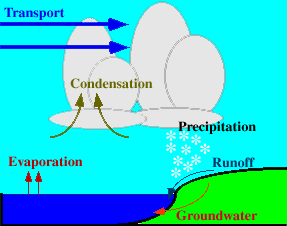|
|
. |
Dynamic/Synoptic Analysis - Background of LES
November 9-14, 1996 in the Great Lakes
1a. Background:
The Greater Cleveland area (Ohio) is the largest population center that
is routinely impacted by heavy lake-effect snowfall (LES) within the
Great Lakes region. The National Weather Service Forecast office (CLE
NWSFO) is located at Cleveland Hopkins airport some 12 miles to the
southwest of the downtown center. Hopkins receives about 50" of snow
annually of which about 40% can be attributed to LES from Lake Erie.
Some 35 miles due east of CLE NWSFO, Chardon - known as the snow capital
of northeast Ohio receives over 100" annually - the majority as a result
of LES.
Greater Cleveland has two snowbelts; a primary snowbelt
running from eastern Cuyahoga (Ki'- ya - ho - ga) county through Geauga
(Jee - aw' - ga), Lake, and Ashtabula counties in extreme northeast Ohio,
and a secondary snowbelt which runs south of the city from southern
Cuyahoga east and south to Medina, Summit, Portage, and northern Trumbull
counties. The snowbelts are so named because of their proximity to the
lake, their higher elevation relative to the lake surface, and
their
orientation to the lake with respect to common wind directions observed
during cold air outbreaks.
[Image: Great Lakes Snowfall (23K)]
LES occurs most frequently in late fall and early winter when polar or
arctic air flows over the relatively warm waters of the lake. There are
great amounts of heat and moisture that "flux" into the lower air stream
induced by the sharp gradient between the cold/dry air and the water
surface; additionally, the cold air over warm water destabilizes the air
column by creating steep temperature lapse rates in the lower
atmosphere. This unstable and moisture laden lower level airmass starts
to rise and form cumulus,
stratocumulus, and even
cumulonimbus clouds
which produce the snowfall downwind of the lakes.
 |
The snowfall
increases on land due to higher elevations (i.e. the airmass is forced to
rise up the sloping terrain) and the change in the frictional elements of
water and land (i.e. land is rougher) which slows the flow and "bends" it
slightly to the left of the overwater trajectories - the result is
convergence of air along the lakeshore. |
The convergence or piling up
of air must be compensated in the atmospheric fluid, thus rising air is
found above the convergence zone - this enhances the lift of the already
unstable air parcels and produces greater snowfall.

Overview
|
|

Stability
|
|


